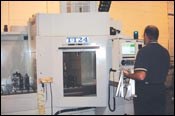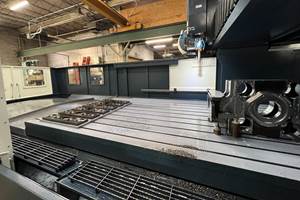Using Twin-Table Machines To Maximize Spindle Uptime
By integrating twin-table, bridge-style machining centers, this shop virtually eliminates spindle downtime during job chang-eovers. An operator can safely set up a new job on a table located outside the machine's workzone while the machine mills a workpiece fixtured on the other table.
Share




Takumi USA
Featured Content
View More



Hwacheon Machinery America, Inc.
Featured Content
View More
Machine tools don’t make money while their spindles are idle. That’s what drives shops to reduce workpiece changeover time during part runs as well as teardown/setup time for new jobs.
Martin-Palmer Tool & Die recognized that minimizing spindle downtime would be critical to successfully entering new markets and winning new customers. As its name suggests, Martin-Palmer Tool & Die started business as a tool and die shop. That was in 1953. Over the years, the Dayton, Ohio shop gained expertise in designing and building specialized material-handling equipment for the automotive industry. Four years ago, however, that portion of the business began to slow. To adapt, the shop started pursuing short-run work that it felt would be too costly for U.S. manufacturers to outsource overseas. It moved away from the automotive industry and began delving into work for the military, commercial products manufacturers and OEMs in other markets. The net result is that now, no one customer represents more than 30 percent of the shop’s gross sales, says co-owner Rich Blevins.
One option the shop considered to reduce spindle downtime was adding pallet changing systems to its existing VMCs. Instead, the shop decided to adopt an atypical, bridge-style machine tool platform from Milltronics that uses two independently positioned worktables. The shop purchased its first Milltronics TT24 twin-table machine in September 2006; its second arrived approximately one year later.
Here are a few reasons why the shop chose such an alternate equipment platform for part runs that fluctuate from 1 to 350, as highlighted by Mr. Blevins:
This machine design delivers on the shop’s need to maximize spindle uptime. An operator is able to safely set up a job on the machine table that is stationed outside the workzone while the machine is cutting on the other table enclosed inside the workzone. Often, the only spindle downtime is the time it takes to shuttle out a completed part and shuttle in a new workpiece. Doors on either side of the workzone close during machining operations to both contain coolant and chips and protect operators as they break down and set up new jobs on the second table. When the new job is set up, the operator presses a “ready” button, and the machine automatically switches the tables upon completion of the current job.
Having integral tables on a common machine base offers rigidity and a small overall footprint. The bridge-style machine has a vertical spindle and two pallets that move independently using linear encoders for accurate positioning under the spindle. Having each table permanently attached to a common base structure and traveling on shared ways results in a stout, sturdy system. This allows the shop to machine materials ranging from aluminum and low-carbon steel to tool and stainless steels.
The TT24’s 24-inch-square table size and healthy weight capacity allow the shop to machine large workpieces. The shop often performs repair machining work on diesel engine blocks such as the one shown on page 101 that weigh approximately 300 pounds. This table is also large enough to accommodate multiple vises, so the machine can complete numerous small workpieces in one setup.
The machine’s conversational control helped streamline the integration of the unfamiliar twin-table platform. The shop has other Milltronics VMCs with the manufacturer’s Centurion conversational control. Control commonality offered operators a level of comfort when learning the ins and outs of operating the new twin-table machines. Conversational programming at the machine uses a menu-based, question-and-answer format that prompts operators for job information and automatically creates the program from that entered data.In integrating this new machine platform, the shop found itself reevaluating the way it typically scheduled jobs for its VMCs. It discovered that the key to optimizing the effectiveness of the twin-table machines is coordinating workpiece cycle times when there are differing workpieces on either table. It is inefficient to mix jobs that have long cycle times with those that have relatively short cycle times.
Related Content
The Cut Scene: The Finer Details of Large-Format Machining
Small details and features can have an outsized impact on large parts, such as Barbco’s collapsible utility drill head.
Read MoreThree-Axis Bridge Mill Opens New Doors for Construction OEM
Different industries often require different machining priorities, a truism recently demonstrated by Barbco, an OEM of heavy-duty boring equipment that opened up new design possibilities by pivoting toward rigid, less complex machining centers.
Read MoreHow a Custom ERP System Drives Automation in Large-Format Machining
Part of Major Tool’s 52,000 square-foot building expansion includes the installation of this new Waldrich Coburg Taurus 30 vertical machining center.
Read More5 Tips for Running a Profitable Aerospace Shop
Aerospace machining is a demanding and competitive sector of manufacturing, but this shop demonstrates five ways to find aerospace success.
Read MoreRead Next
When Four Spindles Make Sense
For the right applications, four-spindle CNC chuckers offer practically zero delay for part loading. That’s because two spindles can be loaded while the other two are making chips.
Read More5 Rules of Thumb for Buying CNC Machine Tools
Use these tips to carefully plan your machine tool purchases and to avoid regretting your decision later.
Read MoreRegistration Now Open for the Precision Machining Technology Show (PMTS) 2025
The precision machining industry’s premier event returns to Cleveland, OH, April 1-3.
Read More





























.png;maxWidth=150)






.jpg;maxWidth=300;quality=90)





.jpg;maxWidth=300;quality=90)









